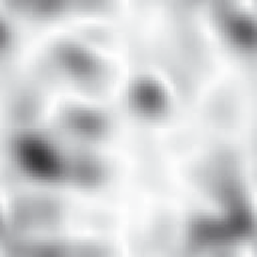Image Processing Reference
In-Depth Information
The function of the wavelet transform is to determine where and how each wavelet
specified by the range of values for each of the free parameters occurs in the image.
Clearly, there is a wide choice which depends on application. An example transform is
given in Figure
2.24
. Here, the Gabor wavelet parameters have been chosen in such a way
as to select face features: the eyes, nose and mouth have come out very well. These features
are where there is local frequency content with orientation according to the head's inclination.
Naturally, these are not the only features with these properties, the cuff of the sleeve is
highlighted too! But this does show the Gabor wavelet's ability to select and analyse
localised variation in image intensity.
(a) Original image
(b) After Gabor wavelet transform
Figure 2.24
An example Gabor wavelet transform
However, the conditions under which a set of continuous Gabor wavelets will provide
a complete representation of any image (i.e. that any image can be reconstructed) have only
recently been developed. However, the theory is naturally very powerful, since it
accommodates frequency and position simultaneously, and further it facilitates multi-resolution
analysis. Amongst applications of Gabor wavelets, we can find measurement of iris texture
to give a very powerful security system (Daugman, 1993) and face feature extraction for
automatic face recognition (Lades, 1993). Wavelets continue to develop (Debauchies,
1990) and have found applications in image texture analysis (Laine, 1993), in coding
(daSilva, 1996) and in image restoration (Banham, 1996). Unfortunately, the discrete
wavelet transform is not shift invariant, though there are approaches aimed to remedy this
(see, for example, Donoho (1995)). As such, we shall not study it further and just note that
there is an important class of transforms that combine spatial and spectral sensitivity, and
that this importance will continue to grow.
2.7.4
Other transforms
Decomposing a signal into sinusoidal components was actually one of the first approaches
to transform calculus, and this is why the Fourier transform is so important. The sinusoidal
functions are actually called
basis functions
, the implicit assumption is that the basis
functions map well to the signal components. There is (theoretically) an infinite range of



















